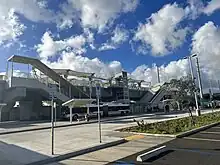Hālawa station
Hālawa station (also known as Aloha Stadium station) is a Skyline metro station in Hālawa, Hawaiʻi, serving Aloha Stadium, ʻAiea, Salt Lake, and Moanalua. The station is located alongside Kamehameha Highway above its intersection with Salt Lake Boulevard. It serves as the eastern terminus of the current rail system and opened on June 30, 2023.[2][3] The station has a 590-space park and ride lot.[4]
Hālawa Aloha Stadium | |||||||||||
|---|---|---|---|---|---|---|---|---|---|---|---|
_Skyline_station_entrance.jpg.webp) The ground floor of Hālawa station | |||||||||||
| General information | |||||||||||
| Location | 99-232 Kamehameha Highway Hālawa, Hawaiʻi | ||||||||||
| Coordinates | 21°22′15″N 157°56′03″W | ||||||||||
| Owned by | Honolulu Department of Transportation Services | ||||||||||
| Platforms | 2 side platforms | ||||||||||
| Tracks | 2 | ||||||||||
| Connections | |||||||||||
| Construction | |||||||||||
| Structure type | Elevated | ||||||||||
| Parking | 590 spaces | ||||||||||
| Bicycle facilities | Racks | ||||||||||
| Accessible | Yes | ||||||||||
| History | |||||||||||
| Opened | June 30, 2023 | ||||||||||
| Services | |||||||||||
| |||||||||||
| Future services | |||||||||||
| |||||||||||
As the eastern terminus, buses provide services along the future right of way via the adjacent bus bay. TheBus Route A CityExpress! provides express service between Hālawa station, Downtown Honolulu, the Ala Moana Center, and the University of Hawaiʻi at Mānoa every 10 minutes, timed with the arrival of trains.[5][6] Route 1L provides limited stop service between this station and East Honolulu via King Street and Waiʻalae Avenue, including stops at Middle Street–Kalihi Transit Center and Kahala Mall.[7] Routes 20 and PH8 provide service between this station and Joint Base Pearl Harbor–Hickam, with route 20 continuing on to the Daniel K. Inouye International Airport, Downtown Honolulu, and Waikīkī.[8]
In Hawaiian, "hālawa" means "curve" and is the name of the ahupuaʻa in which it is located, the easternmost in the ʻEwa District.[9][10] The Hawaiian Station Name Working Group proposed Hawaiian names for the nine rail stations on the ʻEwa end of the rail system (stations west of and including Aloha Stadium) in November 2017,[11] and HART adopted the proposed names on February 22, 2018.[12]
Service
Station layout
| PL Platform level | Side platform, doors will open on the right | |
| Westbound | ← Skyline toward Kualakaʻi (Kalauao) | |
| Eastbound | Skyline (under construction) toward Kahauiki (Makalapa) → | |
| Side platform, doors will open on the right | ||
| G | Ground level | Entrance/Exit, fare gates, ticket machines, bus bays, park and ride lot |
Hours and frequency
Skyline trains run every 10 minutes. Service operates from 5 a.m. to 7 p.m. on weekdays and from 8 a.m. to 7 p.m. on weekends and holidays.[13]
Station information
When all 19 stations are open in 2031, Hālawa is projected to rank sixth in boardings at 4,500 per day.
The station houses a storage track, allowing for the deployment of extra trains for handling large events at nearby venues. The majority of passengers using the station and its park and ride facilities are expected to come from ʻAiea, Halawa Heights, Aliamanu, Foster Village, Salt Lake, and other nearby communities.[9]
Surrounding area

The closed multipurpose Aloha Stadium is located adjacent to the station, the parking lots of which house numerous events including the weekly outdoor Aloha Stadium Swap Meet, featuring over 400 vendors and drawing in over one million annual visitors.[14][15] The City and County of Honolulu expects future mixed-use development in the area to integrate the station with 1,810 new homes, 192,000 square feet of retail, 620 hotel rooms, and 192,000 square feet of office space, anchored by a new stadium with an estimated completion date of 2028. Further higher-density redevelopment is being considered around ʻAiea Elementary School, Stadium Mall, Stadium Marketplace, and the Puuwai Momi public housing complex.[9]
References
- "TheBus-Rail Network 2023" (PDF). City and County of Honolulu. June 19, 2023. p. 3. Retrieved June 30, 2023.
- "'A 21st century system': To fanfare, city announces official opening date of rail's first phase". Hawaii News Now. May 9, 2023. Retrieved May 10, 2023.
- Honore, Marcel. "All Aboard 'Skyline': City Plans To Start Rail Service On 4th of July Weekend". Honolulu Civil Beat. Retrieved May 10, 2023.
- "Skyline Park and Rides". Honolulu Department of Transportation Services. June 16, 2023. Retrieved June 19, 2023.
- Infante, Esme M. (July 1, 2023). "City responds to questions about rail safety for keiki". Honolulu Star-Advertiser. p. A6. Retrieved July 5, 2023.
- "Route A CityExpress! Pearlridge – UH Manoa timetable" (PDF). TheBus. July 1, 2023. Retrieved June 26, 2023.
- "Route 1 Kaimuki – Kalihi and Route 1L Kalihi – Hawaii Kai Limited Stops Aloha Stadium timetable" (PDF). TheBus. July 1, 2023. Retrieved June 26, 2023.
- "Route 20" (PDF) (Map). TheBus. July 1, 2023. Retrieved June 23, 2023.
- Gomes, Andrew (June 29, 2023). "End of Oahu's rail line, initially, stops next to condemned stadium". Honolulu Star-Advertiser. pp. A7. Retrieved June 30, 2023.
- "Nā Inoa" (PDF). honolulu.gov. February 2018. Retrieved April 3, 2019.
- "Hawaiian Station Naming Program" (PDF). Honolulu Authority for Rapid Transportation. November 22, 2017. Retrieved December 19, 2019.
- "HART Board of Directors unanimously approve Hawaiian names for first nine rail stations" (PDF) (Press release). Honolulu Authority for Rapid Transportation. February 22, 2018. Retrieved December 19, 2019.
- "Skyline General Information". Honolulu Department of Transportation Services. June 19, 2023. Retrieved June 20, 2023.
- "Swap Meet & Marketplace". Aloha Stadium – State of Hawaii. Retrieved June 30, 2023.
- Boneza, Jenn (March 1, 2023). "What is the future of the Swap Meet?". KHON-TV. Retrieved June 30, 2023.
External links
![]() Media related to Hālawa station at Wikimedia Commons
Media related to Hālawa station at Wikimedia Commons